Filth, feces, disease, animals dying in agony, destruction of natural environment:

Image: “When a cow ingests a plastic bag, it can clog the stomach, and the animal usually dies in agony. These
bags now blow across our borderlands like tumbleweeds….Courtesy of Warner Glenn. Glenn (right) and husband, Warner, struggle to remove a yellow plastic bag from the stomach of a butchered calf….The silence of the big environmental groups plays a role, too. They should be hollering from tallest buildings about border trash, but they aren’t. Making too much noise might turn off the open-borders liberals they rely on for donations.”
4/2/2009, “Trashing Arizona,” TusconWeekly.com, Leo W. Banks (Alternate link)
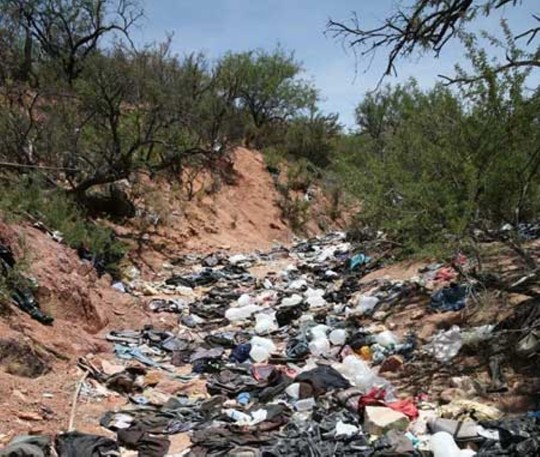
Above, “This trash-filled wash is below Diablito Mountain, about 5 miles west of Interstate 19, southwest of Arivaca Junction. It is 21 miles north of the border at Nogales. The illegal aliens who dump their trash here have just emerged from the Tumacacori Highlands, which are also trashed out….
“Illegal immigrants dump tons of waste in the wilderness every day—and it’s devastating the environment….
Remember Robert Fulghum? He became famous in 1988 with a book called All I Really Need to Know I Learned in Kindergarten. It was a pop-culture hit, a little wise, a little goofy, one of those books that finds its moment, and bam! The whole country knows about it. I’ve been thinking about Kindergarten lately, and the trash dumped on our border lands by illegal aliens. The connection isn’t as tenuous as it might seem, and I’ll get to it in a moment, along with a modest proposal to deal with this huge problem.
First, a question: Have you had your holy-smokes moment yet regarding our illegal-immigration crisis? If not, travel to Arizona’s border region, and go off-road to the game trails, mountain passes and grassland flats that make this area so magical.
In many places, the magic is gone, lost beneath piles of garbage….The litter at Diablito, on state land, was so solid that you could walk a half-mile without your feet touching the sand….
If such a trip is impossible, look at the pictures accompanying this
article. They should provide a jolt, a visual boot to the backside,
after which you’ll proclaim, “Holy smokes! I had no idea!”
......
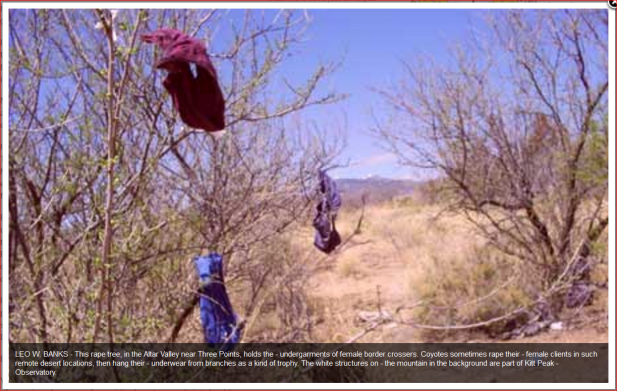
.......
Above: Rape tree: “Leo W. Banks – This rape tree, in the Altar Valley near Three Points, holds the undergarments of female border crossers. Coyotes
sometimes rape their female clients in such remote desert locations,
then hang their underwear from branches as a kind of trophy. The white structures on the mountain in the background are part of Kitt Peak Observatory.”
Most people have no idea. These images should be beamed around the country so everyone can understand Arizona’s crucible.
How
much trash has been dropped since this invasion began? Try 24 million
pounds, from the Colorado River to the New Mexico line [2007 estimate]. The federal Bureau of Land Management made that estimate in 2007 and called it conservative. The agency uses a formula of eight pounds of trash dropped per day, per person.
Based
on this, we can look at certain federal lands and understand the extent
of the pileup. For example, at the peak of traffic in 2004 and 2005,
the Buenos Aires National Wildlife Refuge near Sasabe, southwest of Tucson, was getting 2,000 crossings a day, and that translates to 16,000 pounds of trash a day.
In the early 2000s, the Tohono O’odham Reservation was getting 1,500 crossers daily and 12,000 pounds of trash. The tribe now has workers who march out several times a week to do cleanups,
says Gary Olson, administrator of the tribe’s solid-waste program.
Between September 2004 and December 2008, his workers removed 106 tons.
But aren’t arrest numbers down? Fewer crossers mean less garbage, right?
Yes, although nobody should be jumping for joy. In the 262-mile-wide Tucson sector, the number of crossings has gone from ridiculous to merely intolerable.
In 2005, sector agents made an average of 1,205 arrests a day. Last year [2008], the number was down to 870 daily—which translates to 7,000 pounds of trash.
But remember: Those who get through outnumber arrests by at least 3-to-1. So the real figure is probably closer to 21,000 pounds dropped…every 24 hours.

......
Above: “Leo W. Banks – Dozens of ugly dumpsites just like this one, in the Altar Valley, scar Arizona’s borderlands.”
In the sheer numbers of people, this is a historic migration, far bigger than the 1848 California gold rush—and those grubby, gallant, greedy gold rushers also gave this land a good thrashing.
As the conservation scientist Gary Nabhan tells me, the garbage being left behind today will scar our state’s landscape into the 22nd century.
But there is good news, too. Serious cleanup efforts are underway. In January 2007, the Arizona Department of Environmental Quality launched a cleanup campaign targeted at nonfederal lands within 100 kilometers of the border. Since then, working mainly with volunteers, the state’s Undocumented Migrant Waste Program has collected 56 tons of trash,
in areas such as those along the Santa Cruz River near Tubac and
Tumacacori, on ranches around Arivaca, and on private land near Douglas.
In December, ADEQ joined the Borderlands Management Task Force—a
consortium that includes federal land managers, tribes and state
agencies—to coordinate a border-wide Arizona cleanup.
Its goals, according to Frank Zadroga, manager of Environmental
Quality’s UDM waste program, include launching a Web site, probably by
fall, which will serve as a one-stop data hub. It will also collect
citizen tips about the location of dumps, which are being found in
ever-more remote and sensitive areas.
The Bureau of Land Management has been the major player in picking up garbage on the border since 2003. That year, the agency began its Southern Arizona Project, designed to fix the widespread environmental damage done by illegal aliens and drug smugglers.
The agency doles out taxpayer cash—more than $5 million since 2003—to private and government groups to do this work, and trash collection is part of it. BLM spurs the pickup of about 230,000 pounds a year.
All of this signals hope. Pride of place and home is important, and
the emphasis on volunteers brings together people who, even if they
agree on nothing else, can agree that our borderlands should be restored to their pre-invasion beauty.
Understand the difficulty of the task. The amount of trash still littering Arizona’s landscape tops by several times the amount that has been picked up, says Kathy Pedrick, who administers BLM’s project.
In addition to being in remote areas, these dumpsites are also high-crime zones. After all, drug smugglers often use the same trails as people smugglers. The best routes into our country are bought, and the cartels don’t like anyone mucking around on land they’ve paid good money to control.
Another problem: ADEQ officials say the sites can be contaminated with bio-hazardous waste. What else might be in these dumps? Are communicable diseases present?
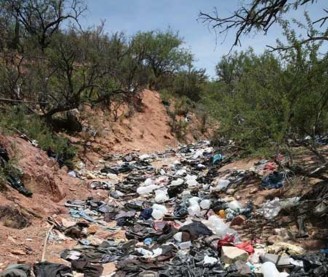 The accompanying photograph to the left shows a site below Diablito Mountain,
5 miles west of Interstate 19 and 21 miles north of Nogales. Illegals
reach this wash after emerging from the Tumacacori Mountains, which are
also trashed out. The litter at Diablito, on state land, was so solid that you could walk a half-mile without your feet touching the sand. In border-speak, the site is called a layup.
The accompanying photograph to the left shows a site below Diablito Mountain,
5 miles west of Interstate 19 and 21 miles north of Nogales. Illegals
reach this wash after emerging from the Tumacacori Mountains, which are
also trashed out. The litter at Diablito, on state land, was so solid that you could walk a half-mile without your feet touching the sand. In border-speak, the site is called a layup.
When illegals prepare to meet their pickup rides, they often drop everything to better squeeze into getaway vehicles. They switch from hiking clothes into street clothes, and off they go, to Los Angeles, Fargo, N.D., Lewiston, Maine, and everywhere in between. The majority of the trash is backpacks, clothing, food cans, toothpaste, toys, water bottles.
But the Diablito site, like dozens of others, includes piles of human feces, tampons, medicines, syringes and even used condoms.
“If a sick person discards a medicine bottle, anyone picking it up might be exposing himself,” says veterinarian Gary Thrasher, who travels the borderlands daily in his work. “You see guys joking around, picking up clothes and hats from these dumps and wearing them.
I don’t know what they’re thinking. People are coming across from down
in southern Mexico, and there are lots of problems you can run into, including cholera.”
The health risk makes land managers leery of using volunteer cleanup crews,
says Keith Graves, former Coronado National Forest district ranger in
Nogales, and now the border liaison between the forest and the Secure
Border Initiative.
“It’s hard to find volunteers we feel comfortable with,” he says. “We have them sign agreements, and that basically makes them federal employees. So if they get injured, we pay for it. We can’t control what they pick up.”
Some
blame the Border Patrol for pushing illegals, and therefore trash,
farther out into previously undisturbed land.
That has happened on national forest land and on Tohono O’odham land, where illegals, because
of increased enforcement, spend more time and probably drop more trash....
Olson acknowledges the trade-off, but says he’s grateful for Border
Patrol help, which—coupled with a declining economy [as of 2009]—has
brought the number of crossings on the reservation down to an estimated
200 to 300 a day.
........
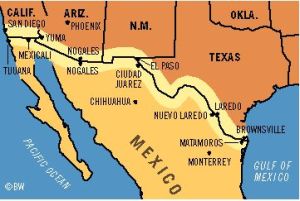 Even so, on the reservation and elsewhere, we’re still talking about lots of people and vehicles. Smugglers load trucks with people or drugs and drive into the country, destroying vegetation and natural springs, and causing serious erosion. On some of our borderlands, enforcement has cut down these drive-throughs.
Even so, on the reservation and elsewhere, we’re still talking about lots of people and vehicles. Smugglers load trucks with people or drugs and drive into the country, destroying vegetation and natural springs, and causing serious erosion. On some of our borderlands, enforcement has cut down these drive-throughs.
Officials in the Buenos Aires, for example, used to find 100 smuggler vehicles a year on its land. But manager Mike Hawkes says new fencing has cut that number dramatically. “Last year, we had one,” he says. Those vehicles, when abandoned, become a form of litter.
But the problem hasn’t been eliminated, and much damage has already been done—in the introduction of non=native seeds, especially buffelgrass.
(See “State of the Desert,” March 5.) It is widespread in Sonora and
enters our country on the wind, on water and on the clothing of the
millions of illegals who’ve already passed through our deserts. It also enters on the tires of smuggler vehicles. The seeds drop in the desert, germinate and grow rapidly. Buffelgrass forces native plants to compete for moisture and space, and it has introduced fire as a major player in the Sonoran Desert.
In the past, fires rarely produced big blazes in the desert. But today, if illegals don’t extinguish their cook fire, or they set a fire to distract law enforcement and then abandon it—two common events—the result can be a runaway fire fueled by buffelgrass. These fires kill plants and trees that set up the desert’s entire regeneration process, and the potential impact is huge.
“We have preliminary evidence that fire changes the whole structure of desert habitats,” says Nabhan, now with UA’s Southwest Center. “Once a fire moves through, it knocks back the nurse trees and permanently alters the desert’s capacity to heal itself.
“This isn’t hypothetical. We’re seeing it from Hermosillo, Mexico, north in a million places.”
Prowling these border dumps provides the equivalent of a graduate-level seminar on what illegal immigration really is, and as importantly, what it’s not. No critical national issue attracts more lame thinking, a good example being the woman who told the Douglas Dispatch in January that border trash tells stories of “hardship and hope.” A visitor from Iowa, she ventured out with a church group to help ADEQ in a cleanup.
I admire her civic spirit. But she’s delusional. The hardship is mostly self-imposed, and there is no hope in garbage.
We know the crossers are a religious bunch, because of the Catholic
medallions, statues and Bibles they drop, and we know they’re
superstitious. The litter almost always includes garlic cloves:
Illegals hang them from backpacks in the false belief that the scent
will keep rattlesnakes away from their campsites.
Some call illegal aliens “undocumented,” but the truth is they have documents falling out of their pockets, literally. Examine the ground, and you’ll find driver’s licenses, birth certificates and passports, most of them forged.
From the Pokémon backpacks, diapers and infant formula, we know the crossers include children. But their debris is often mixed with tequila bottles and pornography. Another item sure to boil the blood: Spanish-language books advising illegals on their rights in the United States.
Less common–but surprisingly present–is evidence that our border has become an international crossing.
As I’ve reported previously in these pages, we know Arabs are coming, from the discovery of three prayer rugs near Douglas and an Arabic diary inside a backpack in Hereford. In 2004, a rancher west of Fort Huachuca answered his door to greet a female illegal wanting to use the phone. The call was to Libya.
A while back, I got an e-mail about a pair of Russian night-vision goggles found near Sonoita. Best guess? They were probably left by drug smugglers. Anna Magoffin and her husband, Matt, who live east of Douglas, found a scarf marked with the word Kaibil—the name of Guatemala’s special forces. The Border Patrol has found machetes and brass knuckles at border dumps, as well as a bulletproof vest more sophisticated than what our troops in Iraq use. The vest, pictured here, is strong enough to repel multiple rifle shots.
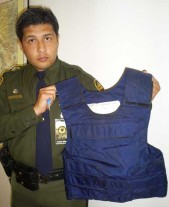 Agents also collect statues and necklaces honoring Mexico’s legendary narco saint, Jesus Malverde. Drug dealers pray to him before bringing their poison into our country. They’re helped by scouts hiding out on mountain tops. At one such lookout, agents found a two-way radio powered by a motorcycle battery, and this, in turn, was rigged to a solar panel the size of a computer screen.
Agents also collect statues and necklaces honoring Mexico’s legendary narco saint, Jesus Malverde. Drug dealers pray to him before bringing their poison into our country. They’re helped by scouts hiding out on mountain tops. At one such lookout, agents found a two-way radio powered by a motorcycle battery, and this, in turn, was rigged to a solar panel the size of a computer screen.
Consider, too, the ugly reality of the rape tree, often found at dump sites. The coyotes who lead groups into the country will sometimes peel a woman out of the group, rape her and hang her panties from a tree as a kind of trophy. The rape tree pictured here [above] was part of a massive dump in the heavily trafficked Altar Valley.
As the Border Patrol’s Mike Scioli says, the underwear is a message to the next coyote coming along—who is, after all, a co-worker of the first one.
“It’s like saying, ‘Look what I did, guys. Now let’s see what you can do,'” says Scioli.
But a site as big as the one pictured [above] might contain
anything. This one also had strips of burlap used to wrap marijuana
bundles, black masks with holes for the eyes and mouth, and a day planner listing a series of phone numbers, including one for coyote Rosa Lima [below].
......
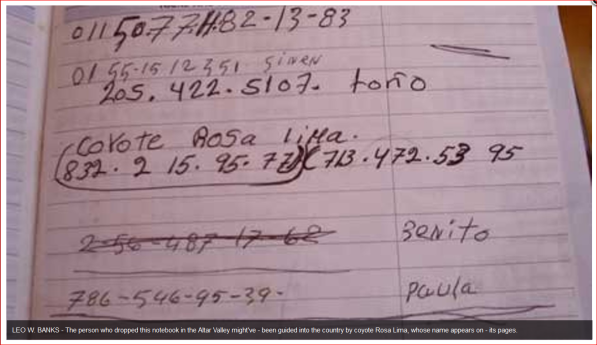
.....
Above: “Leo W. Banks – The person who dropped this notebook in the Altar Valley might’ve been guided into the country by coyote Rosa Lima, whose name appears on its pages.”
When I ask land managers and ecologists about the impact of this trash on wildlife, on water quality, on our deserts overall, the answers are hedging and elusive, with good reason: Little hard research has been done. “I know everybody is worried about it, but nobody has really studied it,” says Thrasher.
It probably won’t be studied in the near future, either. The reason, in part, says Nabhan, is our government’s [alleged] emphasis on security,
which has made it difficult to actually get to the border. He used to
walk from Organ Pipe Cactus National Monument, in Southwest Arizona,
into Sonora to work.
“If you want to do that now, Homeland Security sends your passport back to Washington,” Nabhan says. “Our ability to work on the border has really been knocked back. Even if you get a permit,
it’s dangerous to be out there.”
The agency that would do such studies, the Arizona Game and Fish Department, has not done them because of the danger. “We haven’t looked at these questions directly, mostly because we’re afraid to put our biologists into these areas,“ says Gabriel Paz, a law enforcement program manager for Game and Fish.
“There are too many border bandits.”
But the silence of the big environmental groups plays a role, too. They should be hollering from tallest buildings about border trash, but they aren’t. Making too much noise might turn off the open-borders liberals they rely on for donations. However,
many individual environmentalists have done great work as volunteers,
through hiking clubs, hunting clubs and other organizations, to clean up
the messes.
So politics and the border war conspire to keep us in the dark on border trash.
But scientists know any omnivore that smells food will poke around in it, which explains why garbage has been found in the stomachs of bears and deer.“We know wildlife is chewing on this stuff, but we don’t know the effects,” says Darrell Tersey, natural resources specialist at Ironwood Forest National Monument, north and west of metro Tucson.
But when they went out to the corral the next morning, the calf was dead. Wendy and Warner butchered the animal to learn the cause and discovered a yellow plastic bag blocking portions of its stomach. “It could’ve been suffering for several days before we found it,” says Wendy.
Cattle also eat clothes. “I’ve seen cattle eating clothing to get the salts, and gone back later and found the cow dead,” says Keith Graves.
The desert tortoise is particularly susceptible to the ill effects of alien trash. These critters live in rocky wash banks heavy with vegetation and shade, the same areas where illegals lay up. And the tortoises are slow to reproduce, meaning any knock-back in its population will take a long time to replenish.
Officials at the Ironwood—where 3,000 pounds of trash a year are removed, some left by local citizens—suspected such a population decline and studied the question in 2002. Results were inconclusive. But the authors cited the observation of a longtime resident who has seen fewer tortoises since illegals began using the area in such big numbers.
This fellow also has encountered aliens carrying desert tortoises, and so have staffers at the Cabeza Prieta National Wildlife Refuge and Organ Pipe Cactus National Monument, both in Southwest Arizona. The reason? Probably to cook and eat.
Curt McCasland, manager at the Cabeza, says they’ve also found the shells of five tortoises among the litter at trash dumps. “We don’t know if the trash killed the tortoises, or if the migrants consumed the tortoises,” says McCasland. “We’re not sure what’s happening. We’re too busy monitoring the impacts of illegal immigration on our wilderness areas and haven’t had time or money to study tortoises.”
As for the water supply, it would seem to be especially vulnerable, because these trash dumps are often found at water sources. Some ranchers have reported their wells are contaminated with fecal bacteria, likely the result of so many illegal aliens defecating near water sources. But this issue, too, needs more study.
On national forest land, says Graves, the contamination of wells is less of an issue than the fouling of drinking water for wildlife, such as at open stock tanks. “The contamination there is very high,” he says. Open stock tanks are pits in the ground, usually associated with a stream system. Illegals and animals gather at the tanks and defecate, and when it rains, the waste gets into the tanks, creating sewage-like conditions in summertime.
“If you fill a water bottle at one of these tanks, it has more protein in it than a protein shake because of the animal and human fecal matter,” says Graves.
There’s one additional issue these dumpsites clarify: Illegal immigration into Arizona is just a vast border-area problem, correct?
Not even close. A lot of the trash pickup at the Ironwood takes place on trails threading around Silverbell Mine, 75 miles north of the line. BLM has cleaned alien layups in metro Phoenix and, incredibly, in the Agua Fria National Monument, 40 miles north of central Phoenix.
Illegal alien trash dumps can also be found within the Tucson city limits. Want to see one? Drive east from downtown on Interstate 10, exit at Wilmot Road, and turn left. Follow Wilmot for 1.4 miles; turn left onto the dirt path, park and follow the garbage.
Some of it, on the fringes, is urban trash left by nearby residents. But if you walk back toward the interstate, or west toward the Pima Air and Space Museum, the ground overflows with clothes, backpacks, water bottles and plastic trash bags, which illegals use as raincoats.
When groups hole up here waiting for their pickup rides, they’re aided by locals who make money delivering food and drinks. The evidence is all over the ground, in discarded pizza boxes, Kentucky Fried Chicken tubs and soft-drink containers. The area looks as if it has been carpet-bombed.
The challenge now is not just to maintain cleanup efforts, but to intensify them. It’s necessary, because the illegals are still coming, and we can even expect the flow to pick up in the future, thanks to two decisions by Democratic leaders in Washington, D.C., regarding the E-Verify program. This Internet system, which checks information from a prospective worker against data from the Social Security Administration, is the fairest, most effective method employers have of ensuring that new hires are legally OK to work in the United States.
Funding for E-Verify runs out in September [2009]. Anyone want to guess whether the Democrats will reauthorize it? Don’t bet on it.
The message this sends is obvious: If you’re living here illegally now and need work, or are considering jumping the border tomorrow to find work, the gringos are again winking at their own laws. When the economy picks up, expect crossings to pick up, too, with all of the attendant troubles, including more trash.
But restoring our borderlands, our beloved home, is not impossible. It will take work and persistence, as well as an appreciation of one undeniable, timeless and ultimately redemptive premise: If you drop something, you should pick it up.
The Border Patrol has agents keep garbage bags in their vehicles, and after making arrests at a layup, they sometimes hand the bags to the illegals and tell them to get busy. It’s a great idea. But the concept needs an expansion, and that dovetails nicely with my proposal: Every day, near heavily crossed areas, the Border Patrol keeps buses ready to haul away the day’s arrest harvest. The illegals are processed through law-enforcement computers and often pushed back into Mexico. Before doing that, shouldn’t we put them to work? With the buses already there, it wouldn’t require a huge effort to
force them to clean up their own mess.
It’s one of the bits of wisdom that made Fulghum’s book a hit: All we need are trash bags, stick-spears and the proper amount of righteous indignation. It’ll make kindergarten teachers everywhere smile.”
………………………………
Added:
The largest population transfer on earth for two decades, 1990-2010, was from Mexico to the United States: 7.4 million, p. 23, pdf, Sept. 2016 UN report, “International Migration Report 2015.” In the ten years from 1990-2000, US added 5 million Mexicans, 500,000 each year. In the ten years from 2000-2010, US added 2.4 million Mexicans, 240,000 each year. Total for 20 years, 1990-2010= 7.4 million.
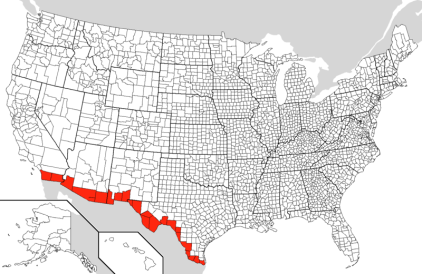


No comments:
Post a Comment